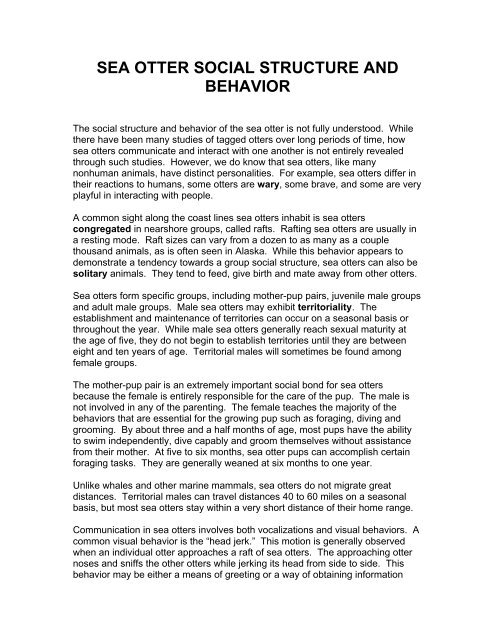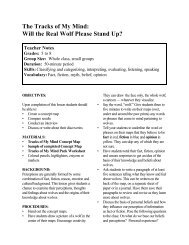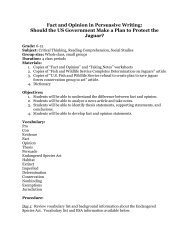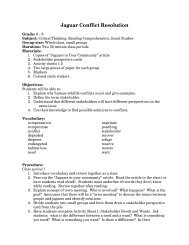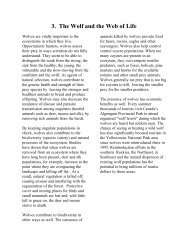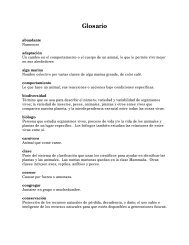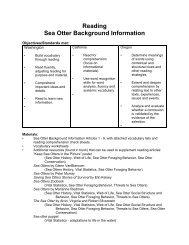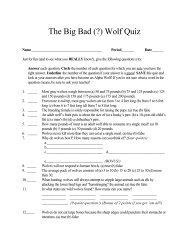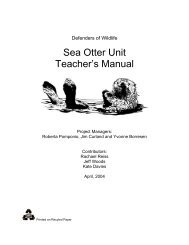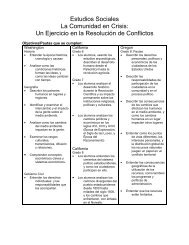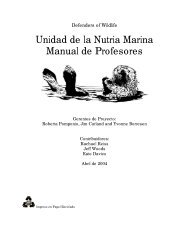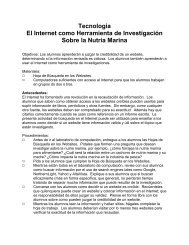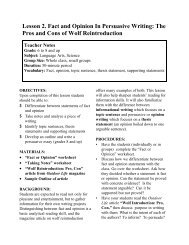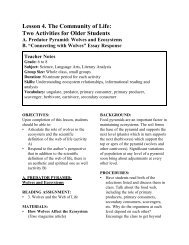SEA OTTER SOCIAL STRUCTURE AND BEHAVIOR - Kids' Planet
SEA OTTER SOCIAL STRUCTURE AND BEHAVIOR - Kids' Planet
SEA OTTER SOCIAL STRUCTURE AND BEHAVIOR - Kids' Planet
Create successful ePaper yourself
Turn your PDF publications into a flip-book with our unique Google optimized e-Paper software.
<strong>SEA</strong> <strong>OTTER</strong> <strong>SOCIAL</strong> <strong>STRUCTURE</strong> <strong>AND</strong><strong>BEHAVIOR</strong>The social structure and behavior of the sea otter is not fully understood. Whilethere have been many studies of tagged otters over long periods of time, howsea otters communicate and interact with one another is not entirely revealedthrough such studies. However, we do know that sea otters, like manynonhuman animals, have distinct personalities. For example, sea otters differ intheir reactions to humans, some otters are wary, some brave, and some are veryplayful in interacting with people.A common sight along the coast lines sea otters inhabit is sea otterscongregated in nearshore groups, called rafts. Rafting sea otters are usually ina resting mode. Raft sizes can vary from a dozen to as many as a couplethousand animals, as is often seen in Alaska. While this behavior appears todemonstrate a tendency towards a group social structure, sea otters can also besolitary animals. They tend to feed, give birth and mate away from other otters.Sea otters form specific groups, including mother-pup pairs, juvenile male groupsand adult male groups. Male sea otters may exhibit territoriality. Theestablishment and maintenance of territories can occur on a seasonal basis orthroughout the year. While male sea otters generally reach sexual maturity atthe age of five, they do not begin to establish territories until they are betweeneight and ten years of age. Territorial males will sometimes be found amongfemale groups.The mother-pup pair is an extremely important social bond for sea ottersbecause the female is entirely responsible for the care of the pup. The male isnot involved in any of the parenting. The female teaches the majority of thebehaviors that are essential for the growing pup such as foraging, diving andgrooming. By about three and a half months of age, most pups have the abilityto swim independently, dive capably and groom themselves without assistancefrom their mother. At five to six months, sea otter pups can accomplish certainforaging tasks. They are generally weaned at six months to one year.Unlike whales and other marine mammals, sea otters do not migrate greatdistances. Territorial males can travel distances 40 to 60 miles on a seasonalbasis, but most sea otters stay within a very short distance of their home range.Communication in sea otters involves both vocalizations and visual behaviors. Acommon visual behavior is the “head jerk.” This motion is generally observedwhen an individual otter approaches a raft of sea otters. The approaching otternoses and sniffs the other otters while jerking its head from side to side. Thisbehavior may be either a means of greeting or a way of obtaining information
about members of the raft through use of the well-developed olfactory sense.When this behavior is performed by an intruding otter, it often will take on a moreaggressive nature through pounces and lunges at members of the raft.Sea otters have a repertoire of vocalizations. One of the most frequently heardsounds when visiting nearshore areas inhabited by sea otters is the high pitchedsqueals of the sea otter pup. This vocalization keeps the pup in contact with itsmother. These squeals enable the mother to find her pup when she returns fromforaging for food. Other sea otter vocalizations include coos, whistles, whines,screams, squeaks, grunts, growls and hisses. These sounds are used in avariety of ways. Grunting and cooing are typically observed in otters when theyare eating. Mother-pup pairs also sometimes coo. Stressed sea otters canwhine, hiss and growl.Although many facets of sea otter behavior and social structure are yet to beexplained, through study and observation, scientists are continually learningmore and more about these unique marine mammals.
VOCABULARYwaryon guard, watchfulcongregatedto collect into a group or crowdsolitarybeing, living, or going alone or without companionsterritorialitythe pattern of behavior associated with the defense of a territoryolfactoryof, relating to, or connected with the sense of smellrepertoirea list or supply of capabilities
1) What are rafts?Check Your Reading SkillsSea Otter Social Structure And Behavior2) Explain why the mother-pup behavior is an important relationship.3) Explain the significance of the “head jerk” that sea otters make.4) Describe some of the common sounds that sea otters make.5) What sounds do humans make to communicate with each other?
Reading Comprehension CheckAnswers1) Rafts are groups of sea otters congregated nearshore. Otters usually raftwhen they are in resting mode.2) The mother-pup relationship is important because it teaches the pup importantsurvival skills. The mother teaches her pup how to forage for food, dive andgroom.3) After a sea otter has entered a group, it will jerk its head from side to side andnose and sniff the other otters. This behavior may be a greeting or a way ofobtaining information.4) Answers may include the following:• High pitched squeals which allows the pup to keep in contact with its mother.• Grunting and cooing sounds are made when otters are eating.• Whining, hissing and growling sounds are made when otters are stressed.5) Answers will vary.


